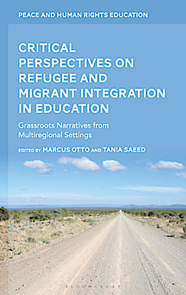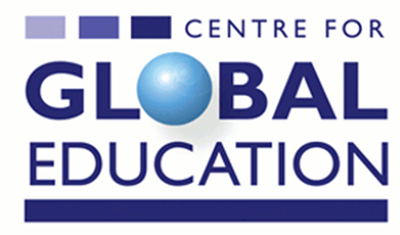Critical Perspectives on Refugees and Migrant Integration in Education: Grassroots Narratives from Multiregional Settings
Development Education and Hope
Marcus Otto and Tania Saeed (eds.) (2025) Critical Perspective on Refugee and Migrant Integration in Education: Grassroots Narratives from Multiregional Settings, London: Bloomsbury Academic. Open access at: https://www.bloomsburycollections.com/monograph?docid=b-9781350452374.
 This book brings together various researchers who are interested in the education and integration of migrants, refugees and internally displaced people in hosting communities. Some of their discussions emanate from first-hand experiences and some of them conduct ethnographic studies or interviews with refugees. The book is accessible, and it targets a broad audience including educators, policy makers, researchers and students interested in issues of migration, integration and inclusive education. The central aim of the book is to critically examine the concept of integration within educational systems in hosting countries. Central questions include how the concept of integration is defined and negotiated within educational systems? And, to what extent is it implemented in relation to inclusivity of refugees and migrants?
This book brings together various researchers who are interested in the education and integration of migrants, refugees and internally displaced people in hosting communities. Some of their discussions emanate from first-hand experiences and some of them conduct ethnographic studies or interviews with refugees. The book is accessible, and it targets a broad audience including educators, policy makers, researchers and students interested in issues of migration, integration and inclusive education. The central aim of the book is to critically examine the concept of integration within educational systems in hosting countries. Central questions include how the concept of integration is defined and negotiated within educational systems? And, to what extent is it implemented in relation to inclusivity of refugees and migrants?
The book is divided into two parts: part one focuses on narratives or real-life experiences of refugees from regions across South America, Asia, Africa, Europe and North America. It sheds light on reframing integration and the role education plays in the process of integration. Part two presents analytical commentaries and a conceptual grasp of the narratives presented in the first part of the book. Authors approach lived experiences or stories of refugees by implementing the concept of ‘thinking with stories’ instead of thinking about stories (Morris, 2002: 196). They made great efforts to live the daily struggles of asylum seekers to understand and unfold various layers of their experiences. They employed a bottom-up approach to gain deeper knowledge and present these stories in an emotional manner which is a powerful approach that draws the reader into the journey of refugees. The book successfully captures the journey of asylum seekers after their arrival in host countries.
These ethnographic chapters reflect the lack of integration of displaced people due to inadequate educational support and focus on the isolation of these refugees in centres that are unable to provide access to public schools. These centres present several barriers to education, such as the lack of transportation, limited financial support and insufficient space for classes. The recurrent themes identified in the first four chapters include: the absence of educational facilities for refugees; a lack of teacher training in areas such as trauma-informed pedagogy and intercultural education; and a lack of inclusive teaching practices. These challenges are linked by a conscious avoidance of hosting states in addressing these needs. This isolation extends beyond separation from the community to exclusion from public schooling. The structural barriers that hinder the integration of these refugees include racism, as well as social and systemic barriers. Although these barriers are commonly shared among refugees, the insight offered by these chapters is more powerful because of the lived experiences shared by authors that illustrate the emotional, psychological, social and institutional impact of exclusion. It also draws our attention to the social injustices experienced by minorities and the urgent need for inclusive education reforms in hosting estates.
Teshome Mengesha Marra’s (2025) chapter, for example, explains that there are efforts to connect refugees with the broader community through the involvement of educators and community leaders. However, the gap between refugees and hosting communities continues to widen, often leading to hostility and the spread of false narratives against refugees. In response, educators have sought to implement pedagogies that are different from traditional approaches – such as pedagogies of care and love – to address the deep isolation experienced by the refugee population. These pedagogies have been shown to yield more effective learning outcomes among refugee learners. Sally Wesley Bonet’s (2025) chapter highlights the example of the Cairo Academic Christian School (CACA), a school established exclusively for refugees. I was struck by how Sudanese students living in camps in Egypt were able to achieve academic success, despite being denied access to public schools and facing harassment in public spaces. One key factor in their success was that their educators also came from similar backgrounds and applied the pedagogy of care. This shared experience allows teachers to empathise with their students’ daily struggles, helping to build a bridge of trust. Therefore, students find safety, comfort, motivation, and hope in their teachers’ pedagogy, which inspires them to believe in a brighter future, and motivates them to work hard and advance in their studies.
It is evident that refugees have made remarkable efforts to integrate into host communities and adapt to their new culture. However, they often face rejection from both the authorities and the public and are subjected to various forms of harassment. The book recalls Freire’s argument that education can function as a tool of oppression (Freire, 2000). A striking example of this is found in Nasir’s educational experience, as detailed in Melissa B. Hauber-Özer’s (2025) chapter. Nasir, a Syrian refugee in Turkey, made significant attempts to integrate; he learned Turkish, took part in community events and advocated for the rights of Syrians. Despite this, he experienced discrimination at college not only from fellow students, but also from professors. Syrian students were excluded from discussions in classrooms, received unfair grading, and were denied academic support. Nasir, for example, was expected to score at least 80 percent on an exam, but he was only given 5 percent. When he approached his professor for clarification, the professor responded: ‘Nasir, there is nothing wrong with your paper, but I will make you fail the exam because you are Syrian’ (Hauber-Özer, 2025: 70). This case study shows how educational institutions can be complicit in systems of exclusion and oppression. For instance, Nasir’s case highlights how higher education institutions often treat Syrian applicants unfairly, sometimes cancelling their registration without just cause. This forces Syrian students to leave college and abandon their academic dreams. The book underscores how difficult it is for refugees to remain motivated and continue to pursue their educational dream in the face of such systemic barriers that constantly work against them.
Sometimes, integration and social cohesion are out of reach for nationals, let alone for refugees and migrants. In the case of Myanmar, as highlighted in Jessica Gregson’s (2025) chapter, internally displaced people like the Rohingya live in isolated camps with substandard living conditions. They are segregated, and there are no governmental efforts to include them in the education system. The chapter provides insights into the lived experiences of Rohingya, revealing educational and contextual details that might elude outside researchers. What really stayed with me is that even if they gain access to public schools, the Rohingya are unable to benefit due to linguistic constraints, as each region uses its regional language as a medium of instruction. The curriculum itself is discriminatory, designed to serve a specific social group. If the system marginalises its own citizens, how can it be expected to welcome and integrate foreign asylum seekers? I describe this as ‘intentional discrimination’ when the state purposefully isolates a group of its citizen and ignores their needs.
Dilek Latif’s (2025) chapter highlights a slightly different situation in Cyprus, a country experiencing a growing number of refugees. Integration encounters challenges because the country is divided and operates two separate public education systems, each with its own ethnocentric versions of history and identity in a segregated society. The strength of this chapter lies in how it raises the question of how newcomers are expected to integrate into a society that is itself divided. It draws our attention to the fact that integration is not a neutral process, but one shaped by the sociopolitical context into which refugees are placed.
The book proceeds to describe the largest refugee influx in 2016 of 1.2 million refugees entering Europe, 40 percent of whom were hosted by Germany. Germany offered better services to refugees and asylum seekers compared to some other countries discussed in this book such as Myanmar, the Czech Republic and Cyprus. However, what I found compelling in Denise R. Muro’s (2025) chapter is that even in systems that genuinely seek to integrate refugees, a single individual can hinder this integration and contribute to their exclusion. This is illustrated by the example of the German teacher assigned to teach refugees. She was unapproachable, serious and strict. She showed little interest in connecting with her students, relied on traditional teaching methods and dominated class discussions. I believe that the chapter could have focused more on the importance of training language teachers in innovative pedagogies such as the pedagogy of love and care to better support and motivate refugees, as language serves as a gateway to the integration process. An important factor discussed in the book is the power dynamics between refugees and the asylum system, as well as refugees and members of the hosting community, which play a significant role. Systems often ignore the needs of these refugees, patronise them and reduce them to case files. Likewise, hosting communities frequently view refugees through a lens of pity. Instead of connecting with them on a human level, they approach them from a position of superiority rather than building a mutual relationship.
The second part of the book provides commentary on the narratives presented earlier and engages with insights from both Germany and Pakistan, drawing on theoretical perspectives derived from the global North and South. I was intrigued by the concept of pluralism and its connection to the concept of integration. Mneesha Gellman’s (2025) chapter emphasises how pluralism can lead to integration not only of newcomers but also of other marginalised groups within local communities. It affirms the principle that every human being has equal rights, regardless of their origin, and that individuals have the right to preserve their identity – unlike political regimes that push newcomers toward assimilation into ‘the language and beliefs of the ethnic majority’ (Gellman, 2025: 142). The chapter highlights how powerful institutions influence education to both control economic power and the identity of individuals. Therefore, public education is far from inclusive, with curricula that lack the flexibility needed to truly integrate newcomers.
Integration can be understood as a political practice, as it is often defined and predetermined by political powers. What is missing in this process, as discussed in Annett Gräfe-Geusch and Johanna Okroi’s (2025) chapter, is the agency of migrants in shaping what integration should look like. As a result, integration becomes a form of ‘one-sidedness’ (Gräfe-Geusch and Okroi, 2025: 153). The chapter argues that to move beyond this one-sided approach, greater attention must be given to the agency of refugees. It also offers valuable guidance on how to achieve both structural and social integration through various approaches, aiming to strengthen the relationship between education and integration. This strongly resonates with me from personal experience as I have seen how migrants and refugees are often excluded from conversations about integration and that everything is decided for them without their input or consent. Saeed’s (2025) intersectional perspective highlights how inclusion or exclusion depend on the extent to which refugees can assimilate and conform within the host community. The level of inclusion or exclusion is largely shaped by how the host state responds to the arrival of refugees, particularly to their identity, race and religion. The book concludes by problematising the notion of integration, arguing that integration remains a deeply troubled concept, even within diverse societies.
Ultimately, each chapter provides a story that captures the everyday realities and struggles faced by refugees living in refugee centres. Many asylum seekers carry stories marked by hardship, loneliness, and isolation, having fled a wide range of circumstances including war, persecution, poverty, and human rights abuses. The book uncovers how asylum systems and host communities contribute to the suffering of refugees, which leads to identity crisis, dehumanisation, and cultural emptying. I believe that the process of assimilation is imposed on refugees when host communities fail to acknowledge the full journey of these asylum seekers prior to their arrival in the state – an issue not deeply discussed in this book and that needs further exploration through narrative approaches. Recognising that displaced people are seeking safety rather than causing harm to host countries can promote empathy, leading to a better integration at both educational and social levels.
References
Bonet, S W (2025) ‘There Is No Future Here: Refugee Youth, Resettlement Tunnel Vision, and Barriers to Integration Pluralism’ in M Otto and T Saeed (eds.) Critical Perspectives on Refugee and Migrant Integration in Education: Grassroots Narratives from Multiregional Settings, London: Bloomsbury Publishing, pp. 53-63.
Freire, P (2000) Pedagogy of the Oppressed, New York: Continuum.
Gellman, M (2025) ‘Integration as a Practice of Pluralism’ in M Otto and T Saeed (eds.) Critical Perspectives on Refugee and Migrant Integration in Education: Grassroots Narratives from Multiregional Settings, London: Bloomsbury Publishing, pp. 141-150.
Gräfe-Geusch, A and Okroi, J (2025) ‘Education and Integration’ in M Otto and T Saeed (eds.) Critical Perspectives on Refugee and Migrant Integration in Education: Grassroots Narratives from Multiregional Settings, London: Bloomsbury Publishing, pp. 151-166.
Gregson, J (2025) ‘Learning as Rohingya in Myanmar’ in M Otto and T Saeed (eds.) Critical Perspectives on Refugee and Migrant Integration in Education: Grassroots Narratives from Multiregional Settings, London: Bloomsbury Publishing, pp. 35-38.
Hauber-Özer, M (2025) ‘Experiences of Syrian Refugee Students in Turkish Higher Education’ in M Otto and T Saeed (eds.) Critical Perspectives on Refugee and Migrant Integration in Education: Grassroots Narratives from Multiregional Settings, London: Bloomsbury Publishing, pp. 65-75.
Latif, D (2025) ‘Problematizing Integration: Impediments to Integrative Education in Cyprus’ in M Otto and T Saeed (eds.) Critical Perspectives on Refugee and Migrant Integration in Education: Grassroots Narratives from Multiregional Settings, London: Bloomsbury Publishing, pp. 115-127.
Marra, T M (2025) ‘The Role of Education in Integrating Refugees into National Systems’ in M Otto and T Saeed (eds.) Critical Perspectives on Refugee and Migrant Integration in Education: Grassroots Narratives from Multiregional Settings, London: Bloomsbury Publishing, pp. 39-52.
Morris, D B (2002) ‘Narrative, Ethics, and Pain: Thinking with Stories’ in R Charon and M Montello (eds.) Stories Matter: The Role of Narrative in Medical Ethics, New York, NY: Routledge, pp. 196-218.
Muro, D R (2025) ‘Community Building and Integration through Education’ in M Otto and T Saeed (eds.) Critical Perspectives on Refugee and Migrant Integration in Education: Grassroots Narratives from Multiregional Settings, London: Bloomsbury Publishing, pp. 129-138.
Saeed, T (2025) ‘Reflections on Host Communities and the State’ in M Otto and T Saeed (eds.) Critical Perspectives on Refugee and Migrant Integration in Education: Grassroots Narratives from Multiregional Settings, London: Bloomsbury Publishing, pp. 167-176.
Ahmed Al-Awthan is a third-year PhD candidate in Education at Maynooth University, where he also works as a part-time lecturer. His research focuses on the educational experiences of asylum seekers and refugees in Ireland, employing narrative inquiry and autoethnography.





